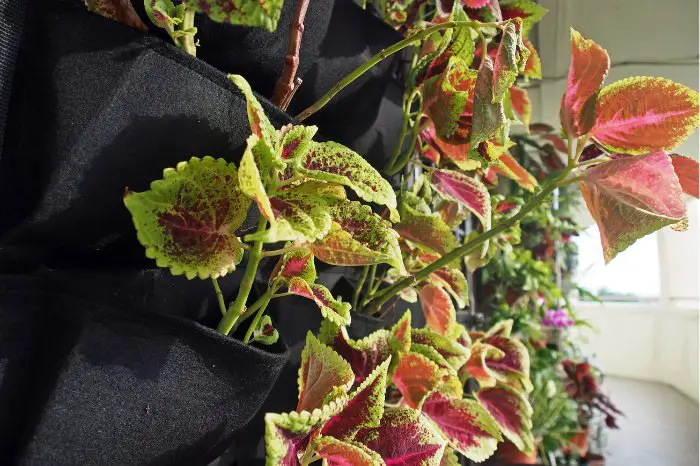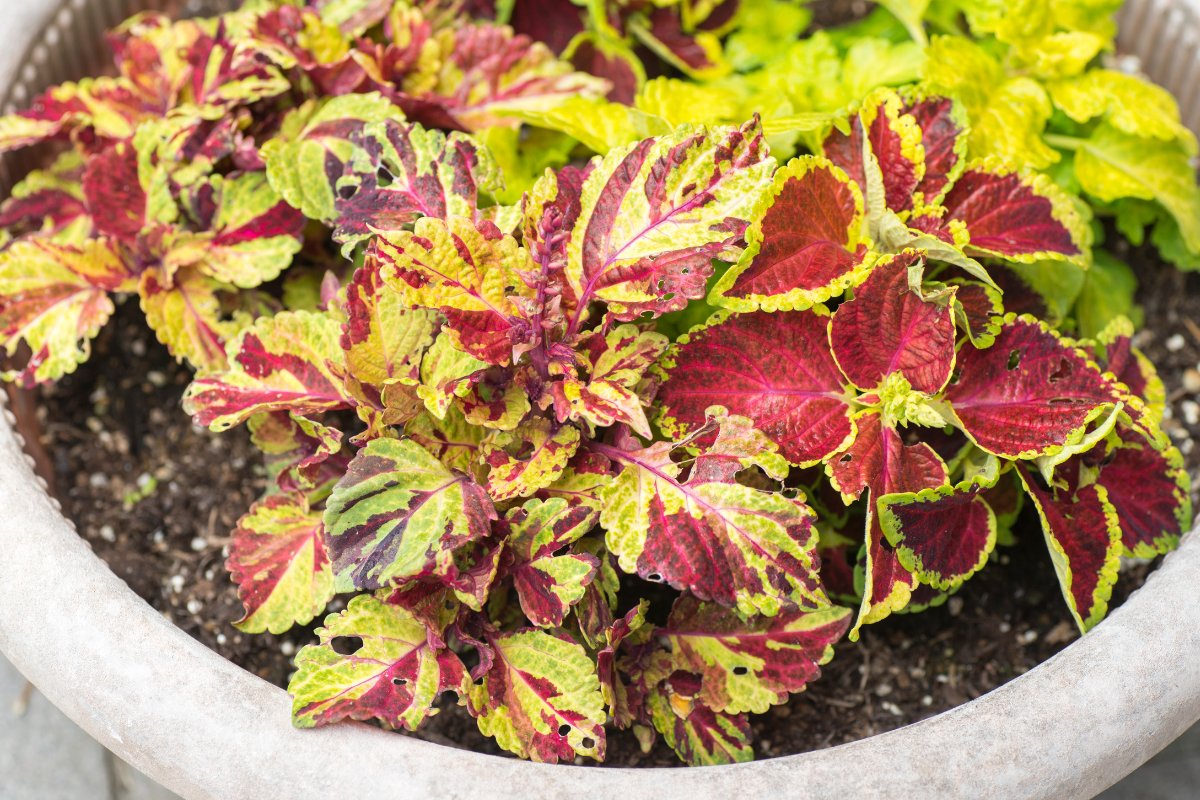Last Updated on January 4, 2023 by Cristina
How to propagate coleus? Or how not to! I get this plant delivered to my house in bags of garden waste and I use these bags as mulch, and the coleus is a pain in the neck! If you give it compost, water and light, it just grows and grows. Based on my experience of accidentally growing so much of this plant I actually hate it, I can give you a few tips on how to grow it if you are having trouble.
What Is A Coleus?
I am always going on about calling things by their species names to avoid confusion. Unfortunately, the Coleus has come back to bite me here a bit. Coleus is a genus name, and there are many species of Coleus. However, it appears that in the way of taxonomists, they have been fighting amongst themselves, measuring leaves, hairs, genomes, and so on, and now have moved a whole lot of things I know as Plectranthus in and out of the genus too and it is basically just a confusing mess!!
From what I can tell, if you are asking “how to propagate coleus” you are probably thinking about Coleus scutellarioides. This is a particularly varied plant – many cultivars have been bred that have brightly colored leaves. Many people grow this plant and love how it forms a dense bed of color. At times they get the garden service to remove bags of excess plant matter, and I then use this as mulch and end up with heaps of Coleus growing all over my vegetable garden!

Coleus in the sense of the above species has a slightly succulent leaf and roots very very easily from cuttings. It will in fact form roots wherever a branch touches the ground. If I actually need to grow coleus somewhere or give one to a friend, I just pull such a rooted branch out and hand it over. They can then invite this monster into their garden so it can take over there too. I am not exaggerating – this plant will take over your garden. It requires a lot of management to keep it contained. Despite what you read – it is invasive.
How To Propagate Coleus In Water
When you have a look around on the internet trying to figure out how to propagate coleus you will find that people make this sound like a really difficult task. I have lots of ponds and pools around my garden, and when I did have coleus near these places they would just hang into the water and grow roots.
Hence I would suggest that if you want to root coleus in water, find somebody (or if you already have plants you can be the donor) and let some of the branches that come out laterally hang in a small tub of water. They will grow roots in a week or two, and then you can snip the branch off, cut off the larger leaves and leave the growth shoots. Place this rooted cutting into the soil and it will grow vigorously.
If you really must, you can take a cutting from just below a growth shoot. Cut the larger leaves off, but leave the growth shoots. Put a little rooting hormone formulated for water rooting as this will speed the process up. Put the cutting in water on a windowsill that does not get intense light and in a week to 10 days you will see little roots emerge. Take the rooted cutting and place it in soil and soon you will have a very rapidly growing plant.
How To Grow Coleus From Cuttings
Well, the way I do it is normally that the stuff comes into my garden mixed in garden refuse and it just roots itself, and then I have Coleus under my maize plants!! But if you want to multiply this plant you can grow it very easily from cuttings.
In recent years I have been experimenting with rooting balls. When considering how to propagate coleus buy more of them than you need as they do get lost – I started with 50 and am down to 10 of them. I normally sneak around and spot plants that I like in a park or public land, and then I clip one on a small branch and root a cutting of the plant. This way I can obtain a wide variety of really interesting plants without having to buy them. However, people will often pinch your cuttings and the ball that goes with the cutting.
Viagrow VPER4 4 cu. ft Perlite Made in USA, 1-Pack, White
These rooting ball systems employ a two-sided “ball” that fits over a branch, and you can then put a bit of compost or coir in there, a bit of water, and some rooting hormone – I normally lightly scratch the stem of the plant to reveal green tissue underneath, and then clip the whole thing over. It works like a charm – after two to three weeks return, with a clipper and cut off the rooted cutting! I have never tried this on Coleus, as I have more of this plant than I actually know what to do with it, but I know it works on similar plants such as catnip.
How To Root Coleus Cuttings
There are many ways you can root coleus. My favorite is actually just to find a branch that is near the ground and bury it in the soil and place a rock on top of this. In a few weeks, it will root naturally. This works with many Plectranthus species which are very similar as well. This is by far the easiest and lowest-effort way to root these plants.
If however, you wish to root cuttings you can just cut them from just below a growth shoot on a stick of the stem. Scratch the tissue around here gently with a knife and then dip the cutting in some rooting hormone and stick it in the potting soil you have in your planters. If you do plan to propagate plants, invest in a cloning chamber. You will never regret it. Plants such as coleus will just root so easily in these. But you can also use them to root up all sorts of other cuttings. I have an old trusty chamber like this that I use to clone my perennial basil, rosemary, and recently even tomato cuttings!!
The important thing with rooting any cutting is to reduce the rate at which it dries out while it roots. Hence removing a few leaves helps, and a cloning chamber also keeps the humidity high. This means the cutting does not dry out and has some energy to put out roots.
Repotting Coleus – How To Propagate Coleus
Repotting coleus is really easy. When I had some in a pot they tended to exhaust the soil and get long and leggy with time. I just empty the pot and then shake the soil off the roots – I always use a potting mix rich in pearlite. Any good potting soil will just become even better for coleus if you mix about a quarter volume of extra pearlite into the mix.
You can then break your coleus clumps up and pot the clumps into new pots filled with the above mix. This allows you to thin the plant out a bit, and also to replace the soil. I normally like to have a very compost-rich soil – these soils break down and vanish with time as the organic matter is converted to carbon dioxide. If you get this soil mix right, you can keep adding compost to the surface of the pot and this feeds the plants. I used to use sticks quite a bit.
I now am more inclined just to take a few shovels of manure and leave it in a bucket with wood ash and bone meal and some bananas for a week. I then strain the gunk out and have a clear liquid that I feed to the plants. The manure provides nitrogen, the wood ash provides potassium and the bone meal phosphates. Bananas contrary to what you will read on the internet contribute very few nutrients – but they do encourage the growth of bacteria that solubilize the nutrients you have added. This is important. I grow my own bananas and always have a few pounds of black mushy bananas to use for such things. I would not add shop bananas – these things are so dipped in every fungicide imaginable – if you have to put the vegetable matter in, put in some pumpkin flesh and peels.
If you feed coleus well they grow like crazy -that is probably the biggest trick you learn in how to propagate coleus like a pro.
In Conclusion – How To Propagate Coleus
If you are struggling and want to learn how to propagate Coleus, duplicate the conditions in my world – a lot of compost (Coleus originally grew on forest floors). Give it a well-drained but nutrient-rich soil. Feed it with compost once or twice a year as a mulch. Re-pot it occasionally to give the plants new space to grow. Coleus is, with the right conditions an absolute pest. It will give you great joy with its colors – and probably spread these colors slowly through your garden unless you keep a careful eye on it. If your soil is poor this problem is less likely to happen.
Dr. Garth A. Cambray is a Canadian/South African entrepreneur and beekeeper with 28 years of experience in apiculture and specializes in adding value to honey. His Ph.D. research developed a new advanced continuous fermentation method for making mead that has resulted in a number of companies globally being able to access markets for mead. His company, Makana Meadery, exports honey mead to the USA where it is available to discerning connoisseurs. He has also developed technologies to commercially manufacture organic honey vinegar in Zambia for export globally. He holds a few patents globally in the ethanol industry and believes in technology and knowledge transfer for human development and environmental sustainability. One of his proudest achievements is the fact that the wind farm he started at one of his old apiary sites has essentially made his hometown carbon neutral.


